10 Must-Try Korean Dishes – Recipes You Can Make at Home
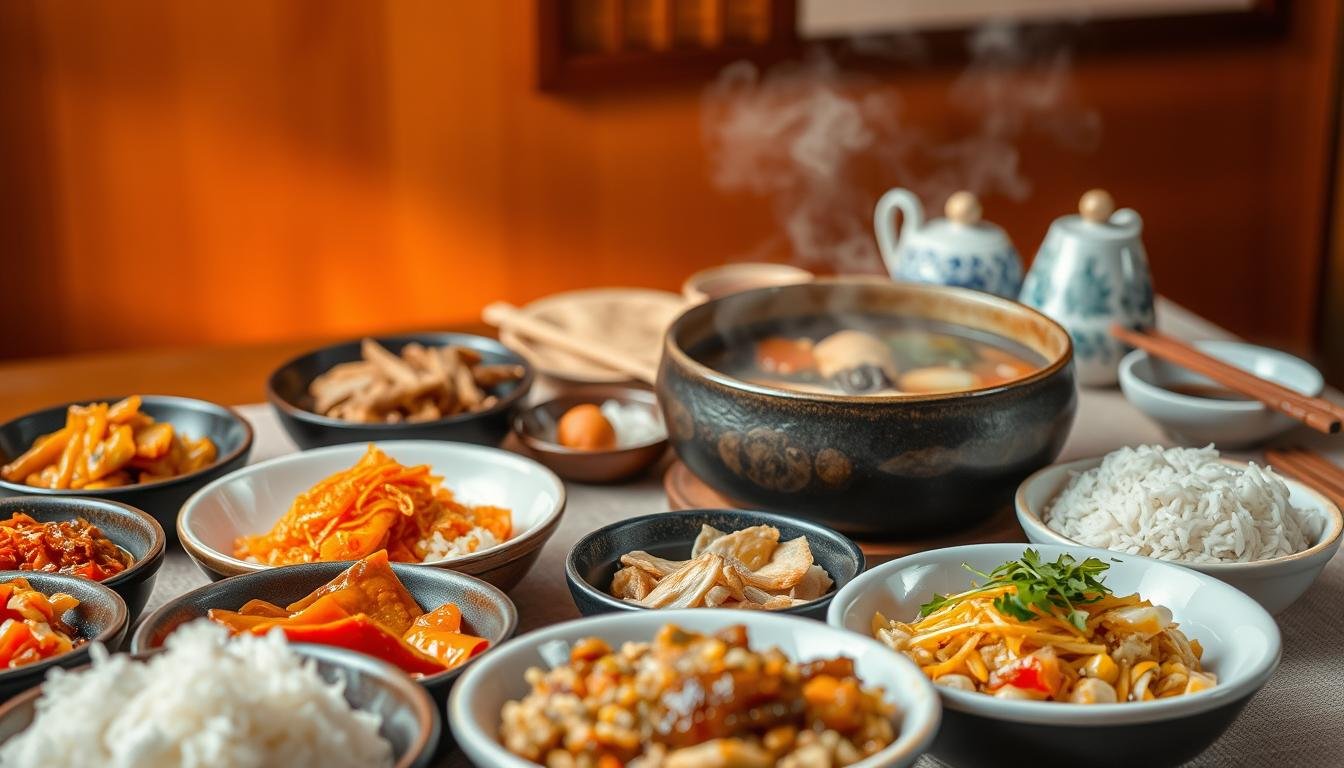
Ever wanted to try new flavors but found recipes too hard? Korean dishes changed my kitchen game. They’re full of life, with their bright tastes, smells, and looks. It’s a party! These recipes are great for all cooks. They bring real Korean tastes to your home.
Picture the tangy taste of kimchi with bulgogi’s deep flavor. Or the crunch of Korean fried chicken with spicy tteokbokki. These dishes have stories to tell. And you can make them easily at home. Ready to start this food journey? Let’s make some quick and tasty Korean meals together!
Key Takeaways
- Explore 10 unique Korean food recipes that are perfect for beginners and home cooks.
- Dishes range from the iconic kimchi to the comforting sundubu jjigae.
- Each recipe is designed to be approachable and packed with authentic flavors.
- Expand your culinary skills with easy-to-follow and quick Korean recipes.
- Bring the vibrant and diverse flavors of Korean cuisine right into your home kitchen.
1. Introduction to Korean Cuisine
Welcome to Korean food wonders! With tasty flavors and bright colors, Korean cuisine delights all senses. It’s rooted deeply in culture, celebrating meal sharing. Join us to explore traditional Korean dishes and their unique charm!
A Brief Overview of Korean Food Culture
Korea’s eating culture is rich with history, tradition, and love. Each meal, from stews to Korean vegetarian dishes, has its own story. It focuses on what’s in season and balance in diets, mixing taste with health.
The Importance of Family Meals in Korea
Family meals are key in Korea. Enjoying authentic Korean recipes together is more than just eating. It’s about bonding, sharing tales, and making memories. These meals highlight family unity and respect.
2. Kimchi: The Iconic Korean Side Dish
Kimchi is a key part of Korean food. It is a spicy fermented veggie dish full of flavor. It’s loved for its taste and health perks. New to kimchi? Our guide makes it easy to start making it yourself.

What is Kimchi?
Kimchi is a Korean dish. It’s made of fermented veggies like napa cabbage and radishes. Chili powder, garlic, ginger, and salted seafood add its special taste. This mix gives a tangy, spicy flavor that goes well with many meals.
Basic Ingredients for Kimchi
To make good kimchi, you need the right fresh stuff. Here’s what you should get:
| Ingredient | Description |
|---|---|
| Napa Cabbage | The main vegetable used in most kimchi recipes. |
| Korean Radish | Provides a crunchy texture and additional flavor. |
| Korean Chili Powder (Gochugaru) | Red chili flakes crucial for that spicy kick. |
| Garlic and Ginger | These aromatics add depth and pungency. |
| Fish Sauce or salted shrimp | Used to enhance the umami flavor. |
| Scallions | For extra freshness and mild onion flavor. |
Simple Kimchi Recipe to Get Started
Want to make kimchi? Here’s an easy recipe for a popular Korean side dish:
- Prepare the vegetables: Cut napa cabbage into quarters. Soak in salt water a few hours until soft.
- Rinse and season: Wash cabbage well. Mix with radish, scallions, garlic, ginger, and chili powder.
- Ferment: Put the veggie mix into a jar with some room at the top. Leave it out for 1-2 days. Then, chill in the fridge for a week to ferment.
Try this easy recipe to enjoy the great taste and texture of Healthy Korean food recipes. It adds a wonderful zing to your meals!
3. Bibimbap: A Colorful Rice Bowl
Bibimbap is a famous Korean rice dish that’s very colorful. It mixes rice, veggies, meat, and spicy gochujang sauce. It looks good and tastes even better. Bibimbap is great for those who want tasty Korean meals or easy meal prep.
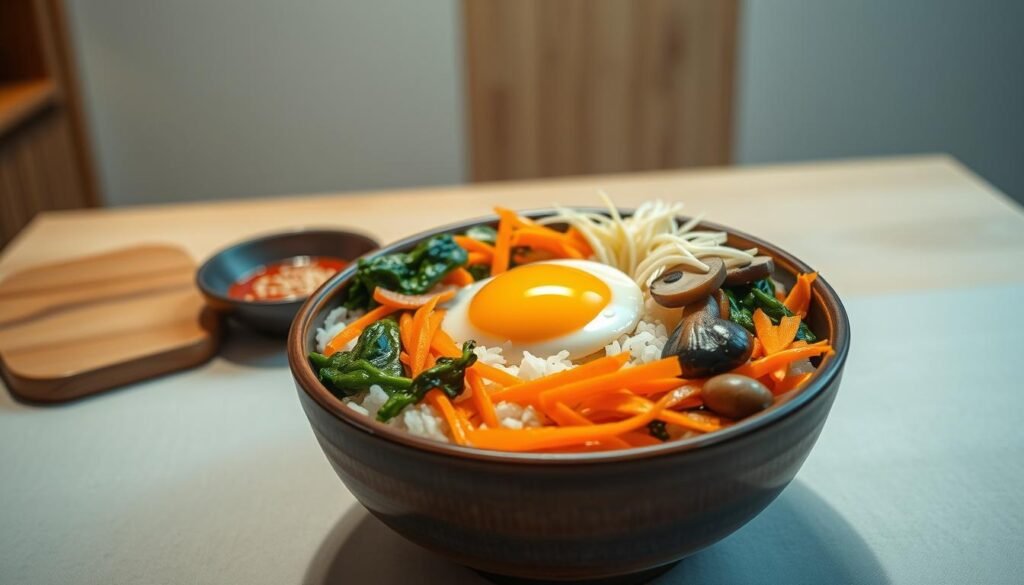
Key Components of Bibimbap
The base of bibimbap is white rice. On top, there are colorful veggies like spinach, carrots, and mushrooms. It’s topped with beef or an egg and gochujang sauce. This sauce brings all the flavors together.
How to Prepare Bibimbap at Home
First, cook some rice. While it cooks, lightly cook your veggies. I usually choose spinach, mushrooms, and carrots. For protein, grill beef slices or fry an egg. Place it all in a bowl and add gochujang.
Variations You Can Try
Be creative with bibimbap! Try chicken or tofu instead of beef. Use any veggies like zucchini or bell peppers. Bibimbap is flexible for meal prep. You can try different combinations.
4. Korean Fried Chicken: A Crunchy Delight
Korean Fried Chicken is a crunchy and flavorful meal loved worldwide. It’s a top choice for anyone looking for quick Korean recipes. In this guide, we’ll explore what makes this dish special. Plus, we’ll show you how to get that perfect crunch at home.

The Unique Flavors of Korean Fried Chicken
This chicken is special because of its flavors. It’s double-fried for extra crispiness. The sauces, like sweet and spicy or garlic soy, make it irresistible. These flavors make Korean Fried Chicken stand out.
Classic Recipe for the Perfect Crunch
Want to make Korean Fried Chicken? Here’s a simple recipe for a great crunch:
| Ingredients | Quantity |
|---|---|
| Chicken wings or drumettes | 2 pounds |
| Flour | 1 cup |
| Potato starch | 1 cup |
| Salt | 1 teaspoon |
| Black pepper | 1 teaspoon |
| Garlic powder | 1 teaspoon |
| Ginger powder | 1 teaspoon |
| Soy sauce | 1/4 cup |
| Honey | 1/4 cup |
| Gochujang (Korean chili paste) | 2 tablespoons |
| Rice vinegar | 2 tablespoons |
Tips for Achieving the Best Texture
To get the best crunch, coat the chicken well with flour and potato starch. Make sure your oil is at 350°F for frying. Double fry the chicken for extra crispiness. Coat it in sauce just before serving to keep it crunchy.
Follow these tips for an amazing dish. Enjoy cooking one of the best Korean chicken recipes!
5. Bulgogi: Marinated Beef Delight
Bulgogi is the essence of Korean cooking’s sweet and savory flair. Known for its tender beef and tasty flavors, it has won hearts globally. It’s a gem among Korean beef dishes, showing the unique taste of Bulgogi.
Understanding Bulgogi and Its Origins
Bulgogi means “fire meat” in Korean and was once enjoyed by royalty. It’s now a favorite in Korean BBQ, blending soy sauce, sugar, sesame oil, garlic, and beef. It’s amazing how this historic dish remains popular and beloved today.
Essential Ingredients for Bulgogi Marinade
Here are the essential items you need for Bulgogi marinade:
| Ingredient | Purpose |
|---|---|
| Soy Sauce | Base flavor and saltiness |
| Sugar | Sweetness |
| Sesame Oil | Nutty aroma |
| Garlic | Spice and depth |
| Green Onions | Freshness |
| Pepper | Subtle heat |
Each ingredient helps create Bulgogi’s unique taste. When marinated right, the beef becomes juicy and tender, filled with these flavors.
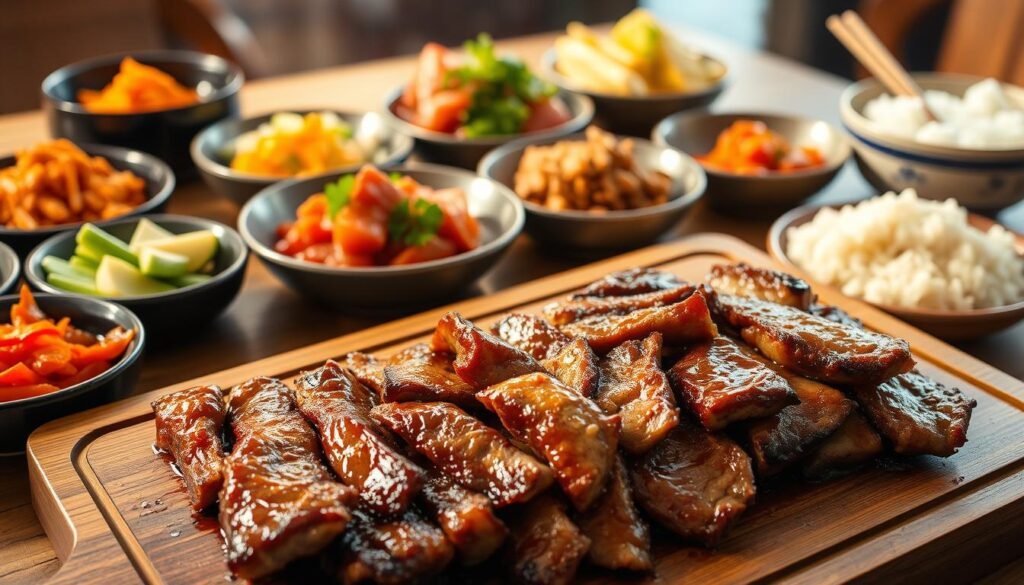
Simple Steps to Cook Bulgogi at Home
Want to cook Bulgogi yourself? Follow these steps:
- Choose ribeye or sirloin and slice it thin.
- Mix the marinade ingredients in a big bowl.
- Soak each beef slice in the marinade well.
- Marinate for at least 30 minutes, or overnight for best results.
- Use a grill or pan and heat it up to medium-high.
- Cook the beef until it’s browned and a bit charred.
You’ve now made a beloved Korean recipe in your kitchen. It’s tasty, easy to make, and perfect with rice and kimchi. Enjoy your meal!
6. Japchae: Sweet Potato Noodle Stir-Fry
Japchae is loved in Korean cooking. It often shows up at big events and family dinners. It’s full of taste and color, making it very popular!

What Makes Japchae Special?
Japchae stands out because of its mix of tastes and textures. The main part is the chewy sweet potato noodles. They are paired with bright veggies and soft beef or chicken.
The noodles soak up the tasty sauce. This makes every bite full of flavor. Japchae is also a treat to look at with its colorful ingredients!
Ingredients Needed for Japchae
Here are the simple, fresh ingredients for this dish:
| Ingredient | Description |
|---|---|
| Sweet potato noodles (Dangmyeon) | These glass noodles are the heart of Japchae, providing a unique chewy texture. |
| Beef or chicken | Thinly sliced, marinated meat adds protein and richness to the dish. |
| Vegetables | A colorful mix of carrots, bell peppers, spinach, and mushrooms for crunch and flavor. |
| Soy sauce | Key for that savory, umami punch. |
| Sesame oil | Adds a nutty aroma and richness. |
| Sugar | BALances the soy sauce’s saltiness. |
| Garlic | Provides a pungent kick that enhances the overall flavor. |
| Sesame seeds | For garnish, offering a delightful crunch and visual appeal. |
Easy Japchae Recipe to Impress Your Guests
Ready to make Japchae? Here’s a simple recipe for family meals or parties:
Step 1: Cook the sweet potato noodles as the package says. Then rinse in cold water and drain.
Step 2: In a bowl, mix soy sauce, sesame oil, sugar, and garlic. Let the meat soak in it for 20 mins.
Step 3: Fry the meat in a hot pan until it’s brown. Then, put it to the side.
Step 4: Fry the veggies in the same pan until they’re tender yet crisp.
Step 5: Mix the noodles, meat, and veggies in the pan. Stir well and heat.
Step 6: Sprinkle sesame seeds on top before serving.
This dish will stand out at any meal. Looking for Korean noodles or easy Korean recipes? Try Japchae. Enjoy its rich flavors and textures, and impress with this Korean dish!
7. Tteokbokki: Spicy Rice Cakes
Ready to try a top street food in Korea? Tteokbokki is famous for being bold and chewy. It’s a must-have in many places, from homes to street stalls. Learn why people love it and how to make it yourself!
The Popularity of Tteokbokki in Korea
Tteokbokki wins many hearts in Korea. It’s a star among spicy Korean dishes, known for its bright color and great smell. This dish is more than just food; it’s a way to bring people together, enjoyed everywhere.
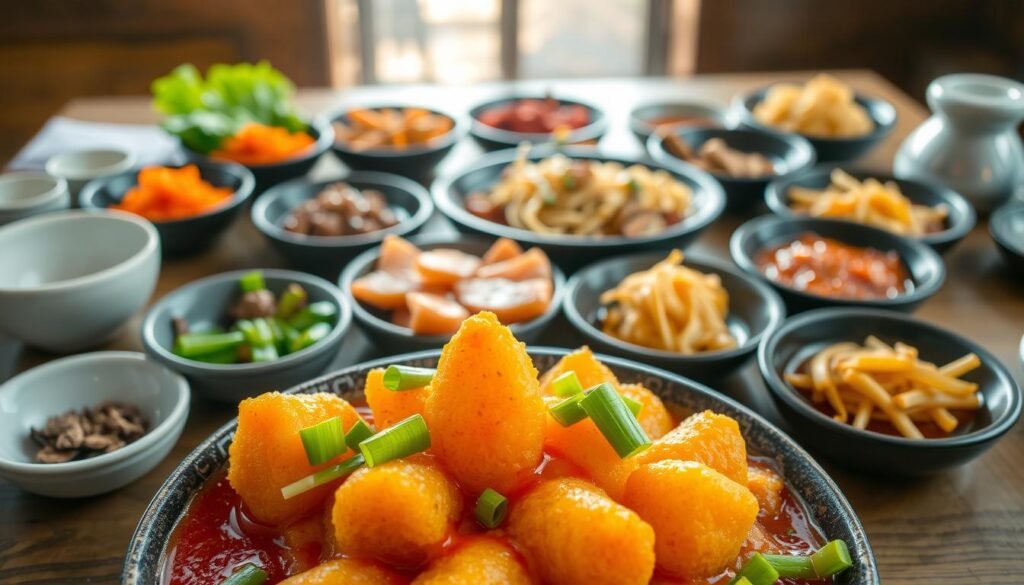
How to Prepare Tteokbokki from Scratch
It’s easy to make Tteokbokki at home! Just follow some simple quick Korean recipes tips. Soon, you’ll enjoy this tasty dish.
| Ingredients | Quantity |
|---|---|
| Rice cakes (tteok) | 1 pound |
| Fish cakes | 1 cup |
| Gochujang (Korean chili paste) | 2 tablespoons |
| Gochugaru (Korean chili flakes) | 1 tablespoon |
| Sugar | 1 tablespoon |
| Soy sauce | 1 tablespoon |
| Water | 2 cups |
| Green onions | 2 stalks |
Tips for Altering Spice Levels
Scared of too much spice? No worries! Adjusting the spice in Tteokbokki is easy. If you like Korean stir fry dishes but less spicy, use less gochujang and gochugaru. Love the heat? Then add more! Tteokbokki can match anyone’s taste.
8. Sundubu Jjigae: Silken Tofu Stew
Sundubu Jjigae is a warm, classic Korean dish, perfect for cold days. It’s a silken tofu stew, rich in flavor and health benefits. Quick to make, it could be your new favorite!
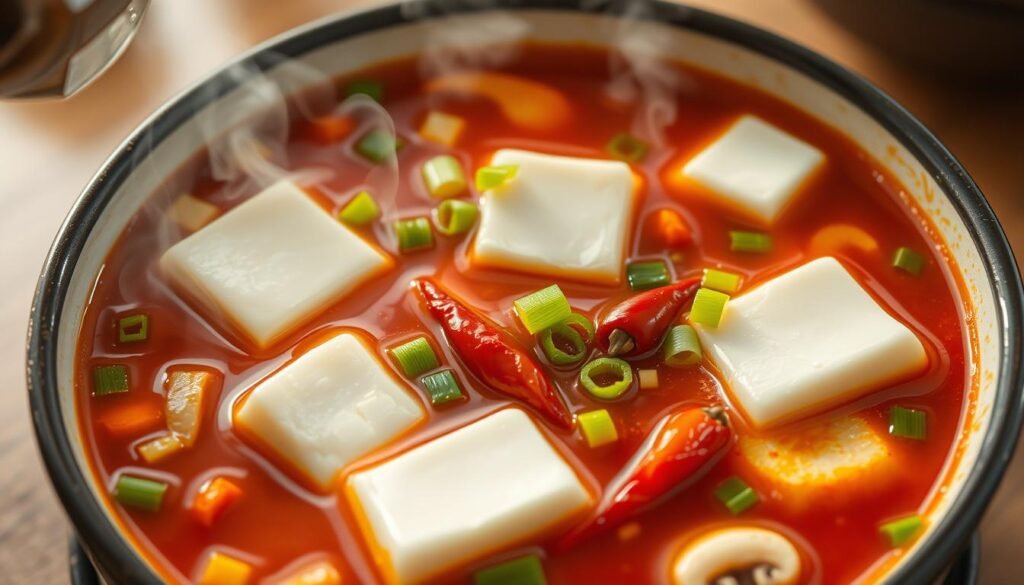
The Comfort of Sundubu Jjigae
Imagine craving something warm on a chilly evening. Sundubu Jjigae is the answer! Its savory broth and soft tofu warm the soul. It’s an easy start for Korean food newbies. Its simple ingredients work together to bring comfort in every bite.
Essential Ingredients for the Stew
Gather these key items to make the stew:
- Soft tofu (Silken Tofu)
- Vegetable or beef broth
- Soy sauce
- Garlic
- Gochugaru (Korean chili flakes)
- Sliced mushrooms
- Green onions
- Sesame oil
This mix makes the stew nutritious and full of Korean flavors. Check your local Asian store or your pantry for these!
Quick Recipe for a Hearty Meal
Follow this quick Korean recipe for a tasty meal:
- Heat a pot with some sesame oil.
- Add minced garlic and gochugaru, cook until they smell good.
- Add the broth and heat it up until it boils softly.
- Carefully put in the tofu and mushrooms.
- Flavor with soy sauce and simmer for 10 minutes.
- Finish with green onions on top before you serve.
Making this classic Korean soup recipe is simple and yummy. Serve it with hot rice for a full, comforting meal. Enjoy your homemade Sundubu Jjigae. It’s the cozy touch your day needs!
9. Kimbap: Korean Sushi Rolls
Kimbap is super popular in Korea, and some call it Korean sushi rolls. It mixes ingredients in seaweed and rice. This makes it great for picnics, lunches, or Easy Korean meal prep. Let’s look at what kimbap is, its key ingredients, and rolling tips!
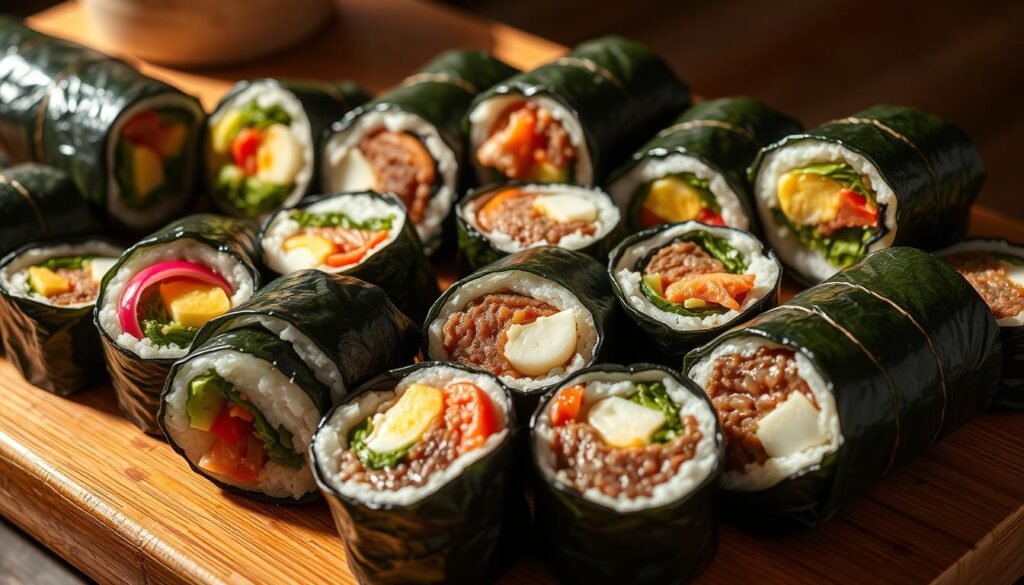
What is Kimbap?
Kimbap, also known as gimbap, is a tasty Korean dish. It’s made with steamed rice and fillings like veggies, fish, and meat, all in seaweed. It’s different from Japanese sushi because it doesn’t have raw fish. So, it’s good for those who like cooked or plant-based options. It’s a popular appetizer in Korea for its versatility and flavor balance.
Ingredients for a Simple Kimbap
Kimbap is easy to customize. Here are some basic ingredients for a tasty roll:
| Ingredient | Description |
|---|---|
| Seaweed Sheets | These hold everything together. |
| Cooked White Rice | Add sesame oil and salt for taste. |
| Carrots | Julienne, lightly sauté. |
| Pickled Radish (Danmuji) | It’s bright yellow and adds crunch and tang. |
| Egg | For protein, add thinly sliced omelet. |
| Spinach | Blanched and seasoned, it tastes fresh. |
| Proteins | Try crab sticks, bulgogi, or tofu for veggies. |
Change up the fillings to fit your taste and needs!
How to Roll Kimbap Like a Pro
Rolling kimbap can seem hard, but you can learn! Follow these steps:
- Place seaweed on a sushi mat, shiny side down.
- Put a thin layer of rice on the seaweed, leave space at the top.
- Add your fillings in the middle of the rice.
- Roll it tight using the mat.
- Seal the end of the roll with water.
- Cut the roll into pieces, clean your knife to avoid sticking.
There you go! You made kimbap. It’s perfect for any Easy Korean meal prep time. It’s easy enough for beginners with some practice. Have fun making these Korean sushi rolls. You’ll wow your friends and family with your cooking!
10. Conclusion: Embracing Korean Cooking at Home
You’ve discovered many Korean dishes to make at home! Enjoy the spicy Kimchi, colorful Bibimbap, or crunchy Korean chicken. These meals offer a splash of flavor and a kitchen adventure.
Encouragement to Try These Recipes
Trying Korean comfort food might seem hard, but it’s truly rewarding! Don’t hesitate to start with any recipe mentioned. You’ll enjoy making these dishes and wow your loved ones.
Tips for Exploring More Korean Dishes
Don’t stop at these recipes. Keep trying more Korean meals by using new ingredients and methods. Visit local Korean stores for fresh products and tastes. More practice will make you a pro at Korean cooking at home.